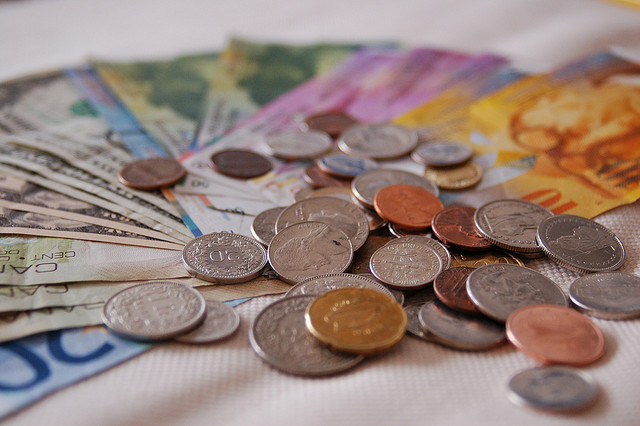Translation of the original German article on helicopter money by Michaël Malquarti, senior vice-president at Geneva-based SYZ Asset Management, published in German in the Neue Zürcher Zeitung on 16th of February 2015. An abbreviated version of the article was published in French in the Le Temps.
Since the outbreak of the 2008 financial crisis, central banks have carried out unprecedented measures to avoid a systemic melt-down and to fight deflation. While a collapse of the system has been avoided, the peril of deflation remains. It is interesting to note that the actions taken so far have been restricted to conventional fields only: fixed income markets, to stimulate investment, and foreign exchange markets, to stimulate net exports. These measures are therefore exceptional because of their sheer scale, rather than because of their originality. They are also controversial: there are doubts with regards to their effectiveness, they create distortions in the allocation of resources and they require macro-prudential measures – which can be unfair and restrict individual freedom – in order to mitigate undesirable side-effects, such as financial and property bubbles.
Investment and net exports usually account for only a relatively small proportion of gross domestic product (GDP), around 23% and 12% respectively in Switzerland in 2013. Central banks have no control on the other two components of GDP, namely current government spending (11% of GDP) and more importantly private consumption (54%). While the monetisation of public spending can be politically contentious, it can only be due to a sheer lack of imagination that no action has been taken over private consumption.
In order to prevent the risk of deflation, I propose to act directly on consumption by providing the central banks with a new monetary policy tool: the distribution of an individual monetary ration. This basically implements Milton Friedman’s famous “helicopter money” drop – in a thought experiment he suggested to fight deflation by throwing banknotes from a helicopter. So far this concept has mainly been mentioned in connection with the monetisation of public debt. Here the idea is radically different: in practice each resident would directly receive from the central bank a lump sum of money, the size and distribution frequency of which would be decided independently from government and for monetary policy purposes only.
This is not about introducing an unconditional basic income, which is a fiscal policy instrument aimed at redistributing wealth. Also, this distribution must not lead to a loss for the central bank, since that would turn it into a form of covert budgetary policy measure. So, the payment would have to be offset on the balance sheet of the Swiss National Bank (SNB) by creating an asset, for example a high denomination coin or an unredeemable zero-coupon bond.
The monetary ration instrument is liberal because you can use it any way you want. Moreover it is fair, because although its marginal utility differs from one person to another, it has the same impact for all. It increases households’ purchasing power and tax revenues without raising labour costs or taxes. It boosts consumption and reduces debt. Unlike other solutions, such as the monetisation of public debt, the temporary distribution of a monetary ration does not lead to any moral hazard, as the central bank acts independently. In particular, this instrument keeps the need for budgetary discipline unchanged.
The distribution channel of the monetary ration must be secure and flexible; it must allow for regular small-sum adjustments to ensure it remains a proper control tool. The reason why Milton Friedman’s idea never got beyond the thought experiment stage is probably that is was hard to implement in a practical and fair way. Today, thanks to the development of information technology and to the existence of many money transfer structures, the idea can be considered seriously. In Switzerland it could easily be carried out: we could go through the basic health insurance system, which we already use to redistribute the CO2 tax. Since all Swiss residents subscribe to one basic health insurance scheme, such a distribution channel would reach the entire population, while minimising the risk of error. Moreover, the structure is already in place and implementation costs would be negligible.
Every Swiss citizen could receive up to 100 swiss francs a month
To give an idea of the order of magnitude, in Switzerland the ration could amount to around 100 Swiss francs (90 euros) per person per month, that is annually about 1.5% of GDP and, depending on the aggregate, 1 to 2% of the money supply. This is far less than the over 50% of GDP that the SNB has spent in recent years purchasing foreign currencies. If we make the reasonable assumption that most of the distribution will be quickly spent, then, all things being equal, the impact on inflation would be the same, i.e. around 1 to 2% annualised. The introduction of such a ration, or even the mere mention of its potential distribution, could lead foreign investors to sell Swiss francs and thus weaken our currency.
Switzerland could be a pioneer in introducing this new tool. Since it satisfies the proponents of budgetary discipline as well as those who support boosting purchasing power, since it does not affect free market dynamics, whilst improving the lot of the poorest, this idea should certainly obtain a broad political consensus. Switzerland could also stand as an example for the rest of the world and particularly for our neighbours who are in even more dire need of a solution than we are.

